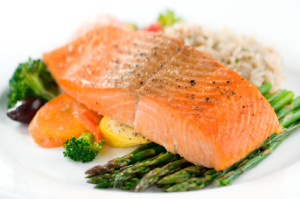With a greater push toward healthy eating, we are being encouraged to eat 2 servings of fish or seafood a week. Concurrently, the question of whether farmed fish or wild caught fish is better grows more prevalent.
The knee-jerk environmental response would be to assume that farmed fish is the way to go to protect native fish stocks, but delving into this question is like opening the proverbial can of (fishing) worms. The answer depends upon the balance of a number of factors such as:
- The species of fish
- The region in which it is fished or farmed
- The fishing or farming practice employed
- The environmental impacts of the practice
- The nutritional value of the fish
Take salmon for example. A delicious fish, prized for its high omega-3 fatty acid content which reduces the risk of cardiovascular disease in adults, and promotes eye health and brain development in infants. Pacific salmon is generally caught in the wild around the west coast of the United States, and Alaska. Atlantic Salmon on the other hand, is predominantly farmed and derives from countries such as Norway, Chile, Scotland and Canada.
Atlantic salmon farming in the above countries is conducted in large open pen nets. Because of the high density of fish growing in these nets, farmed salmon are at an increased risk of contracting diseases and attracting parasites such as sea lice. This increased risk on farmed stocks then increases the exposure of disease and parasites to wild fish stocks as they are transferred from one to the other. To combat these two common problems, fish farmers inject chemicals and antibiotics into the fish food to protect their stocks. Not only does that sound unsavory, but with similar fears experienced in the agriculture industry, the wide spread use of antibiotics in food, if exposed to humans on a large scale, could mean the evolution of antibiotic resistant bacteria.
While efficiencies of Atlantic salmon farming have improved in the last decade, they still require about 1.5 – 3 lbs of fish meal or fish oil (sourced from wild stocks) to produce 1lb of salmon. When we also take into account the waste and effluent produced by these high density fish pens, the overall picture of Atlantic salmon farming is not so rosy, and probably not what most of us expected.
On the contrary, Pacific salmon is caught in the wild using drift and set gill nets. These are a kind of nets specifically designed to target salmon of a particular size and shape to minimize the collateral damage to other fish species living in the area. The nets themselves, as the name suggests, drift as opposed to being anchored to the sea floor and therefore do not cause the kind of environmental degradation we are accustomed to seeing with dredging operations.
The industry itself is also highly regulated due to the fragility of fish stocks over the last few decades because of habitat loss, over fishing, and climatic shifts. Particularly in California, Oregon and Washington, agencies are strictly managing in the industry to ensure the salmon population bounces back. Alaskan salmon stocks however, are more robust which means wild salmon caught from this region do not endanger the local population growth numbers.
On the nutritional front, you might also expect that wild salmon is better for you than farmed salmon. In fact, farmed salmon has a higher omega-3 fatty acid content, largely due to the fact that they are not as active as wild salmon. This is understandable given that the wild fish need to search for their own food. While being lower in omega-3, the wild salmon diet comprising of kelp and algae provides a greater nutritional benefit in terms of calcium and iron than their farmed counterparts. So another balancing act is needed.
Overall, the wild caught fish has trumped the farmed fish, at least when it comes to salmon. But of course, the contrary may be true given a different species of fish, how they are farmed, how they are fished, what they are fed, and where they are caught.
Trout is an example of a species that is best bought farmed than caught in the wild. Native trout stocks, particularly from the Great Lakes region, are so heavily depleted from over fishing, habitat destruction, and predation from foreign introduced species, that continuing to consume wild caught trout threatens the survival of this species.
Tilapia is another species where the benefits of farming outweigh catching the fish in the wild. This fast growing, native African species is a favorite in the US. So much so that US fish farming techniques have advanced to develop recirculating aquaculture systems that not only reuse water from the ponds or tanks, but treat the effluent of the fish, thereby reducing the risk of disease and the need for antibiotics. Because tilapia fish farms are inland as opposed to open water operations, transference of disease to native fish is eliminated.
Farmed tilapia is also fed grains such as soybean, corn and wheat as opposed to fish meal and fish oil. In the highly optimized recirculating aquaculture systems, the effluent and waste water from the tanks serve as fertilizer for the feed crops. So tilapia is a great example of an environmentally sustainable fish to consume.
Unfortunately, there is no straight forward answer to whether farmed fish is better than wild fish. But organizations such as Seafood Watch can help decipher the maze of seafood options. Check out their website here.



